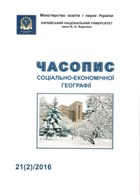Optimizing allocation of catering institution establishments through the urbogeosystem GIS-analysis (case study of Kharkiv)
Abstract
The paper introduces one more example due to the urbogeosystem (UGS) function research through the GIS-tools for a megalopolis in addition to that one previously published and related to the city well-being spatial differentiation. In this case the establishment of catering institutions over the city area has been provided for consideration with GIS-tool as a urbogeosystem function. Some conceptual basics of the urbogeosystem GIS-analysis have been introduced once again too. The municipal human sphere is shortly described as a key city attribute. Visualization and analysis of the catering institution spatial distribution has been completed within an advanced GIS-interface. The urban population density, population income, and the transportation network have been defined as three key factors of the catering institution allocation. Zone burring methods have been accepted as a main tool for these key factor definition. Mentioned parameters have been processed by applying the human geography formalized methods. All key modeling buildings have been visualized in the ArcGIS user’s interface. Two scaling levels – a whole city area and its single administrative district – have been chosen for this visualization. Summarizing all introduced modeling, analysis and visualizing it is possible to conclude, that analytical abilities of the GIS together with various spatial data formats are the only tool for the variant analysis of the urban infrastructure. The two-level cartographic GIS-model of the city parcel spatial allocation with sufficient, insufficient, and desirable numbers of catering institutions must be considered as the main applied result of this research. The applied approach of the trade area definition for a catering institution has been grounded, proved, and calibrated.
Downloads
References
2. Kostrikov, S.V. (2014). Geoinformatsiynyi pidkhid do analizu urbogeosystem na pidstavi tekhnologii lazernoho dystantsiynoho zonduvannya [Geoinformation approach to analysis urboheosystems based on laser technology re-mote sensing]. Region-2014: Strategiya optymalnoho rozvytku: Materialy mizhnarodnoi naukovo-praktychnoi kon-ferentsii. Kharkiv, KhNU im. V.N. Karazina, 31-34.
3. Kostrikov, S.V. (2014). Geoinformatsiyne modelyuvannya pryrodno-antropohennoho dovkillya. Naukova monografiya [Geoinformation modeling of natural and anthropogenic environment. Scientific monograph]. Kharkiv: KhNU im. V.N. Karazina, 484.
4. Kostrikov, S.V., Kulakov, D.L., Sehida, K.Iu. (2014). Programne zabezpechennya GIS dlya LiDAR-tekhnologii dystantsiynoho zonduvannya v tsiliakh analizu urbogeosystem [GIS Software for LiDAR-technology remote sens-ing in order to analyze urboheosystem]. Problemy bezperervnoi geohrafichnoi osvity i kartografii, GIS-forum 14. Zbirnyk naukovykh prats. Kharkiv, KhNU im. V.N. Karazina, 45-52.
5. Kostrikov, S.V., Chuiev, O.S. (2016). Analiz dvorivnevykh urbogeosystem cherez zasoby GIS [Analysis duplex urbogeosystem by means of GIS]. Visnyk KhNU: Geologiya, Geografiya, Ekologiya. Kharkiv: KhNU im. V.N. Karazina, 44, 98-109.
6. Likhacheva, E.A., Timofeev, D.A., Zhidkov, M.P. (1996). Gorod – ekosistema [City is ecosystem]. M.: IGRAN, 336.
7. Niemets, K.A., Niemets, L.M. (2014). Teoriya i metodologiya geografichnoi nauky: metody prostorovoho analizu u suspilniy geografii. Navchalno-metodychnyi posibnyk [Theory and Methodology of geography, spatial analysis methods in social geography. Textbook]. Kharkiv: KhNU im.V. N. Karazina, 172.
8. Novyi KVED. [New Classification of Economic Activities]. Holovne upravlіnnya statystyky. Available at: http://www.kved.com.ua.
9. Oliynyk, Ya.B., Stepanenko, A.V. (2000). Vstup do sotsialnoi geografii: Navchalnyi posibnyk [Introduction to Social Geography: Textbook]. K: T-vo «Znannia», KOO, 204.
10. Radchenko, L.O. (2006). Organizatsiya vyrobnytstva na pidpryemstvakh hromadskoho kharchuvannya: Pidruchnyk [Organization of catering, Textbook]. Rostov N-D: Feniks, 352.
11. Tikunov, V.S. (2005). Modelirovanie v sotsialno-ekonomycheskoi geografii [Modeling in the socio-economic ge-ography]. M.: Izd-vo MGU, 280.
12. Chuiev, O.S., Kostrikov, S.V. (2015). Otsinka cherez GIS-zasoby prostorovoi dyferentsiatsii blahoustroyu mista yak funktsii urbogeosystemy (na prykladi m. Kharkiv) [Evaluation by means of GIS spatial differentiation city im-provement urbogeosystem as a function (on example of Kharkiv)]. Chasopys sotsialno-ekonomichnoi geografii. Kharkiv: KhNU im. V.N. Karazina, 18 (1), 52-62.
13. Shypulin, V.D. (2014). Osnovy GIS-analizu: navch. posibnyk [Fundamentals of GIS Analysis, tutorial]. Kh.: KhNUMH, 330.
14. Leis, T.H. (2005). ArcGIS. ArcMap. Rukovodstvo polzovatelya [ArcGIS. ArcMap. User Manual]. M: Izd-vo MHU, 558.
15. Bourne, L.S., Simmons, J.W. (1978). Systems of Cities: Readings on Structure, Growth, and Policy. Oxford: Oxford University Press, 565.
16. Du, G.Q. (1997). A Study on the relationship of regional urbanization and socio-economic structure in China. An-nals of Japanese Association of Economical Geographers, Tokio: Ohai Chio, 43, 151-164 (in Japanese with English abstract).
17. Kostrikov, S.V., Sehida, K.Iu. (2013). Human geography with geographical information systems (in English). Chasopys sotsialno-ekonomichnoi geografii. Kharkiv: KhNU im. V.N. Karazina, 15 (2), 39-47.
Copyright (c) 2016 Віктор Безрук, Сергій Костріков, Олексій Чуєв

This work is licensed under a Creative Commons Attribution 4.0 International License.




